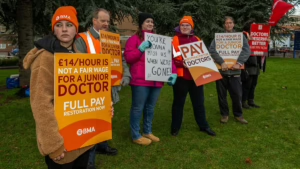The Employment Rights Bill will bring about some welcome and profound reforms. Karl Bennett argues that underlying issues such as health, well-being, presenteeism, and productivity still need to addressed.
The government’s Employment Rights Bill proposes the most significant changes to UK workplaces in decades.
The new government, with an agenda centered around economic growth, has focused on improving productivity and unlocking employee’s potential. This can be achieved by increasing commitment and motivating employees.
There is no doubt that the new ‘rights,’ which are being introduced are important in re-energizing the workplace contract. However, there are questions about what these rights will mean to some of the issues at the core of productivity.
There are also serious problems with mental illness, stress and burnout. Will the plans for workplaces have any impact on employee health and well-being?
There are 28 reforms in the Employment Rights Bill. Some of them are directed at protection and security.
Some proposals will eliminate the two-year qualification period to protect against unfair dismissal. Others ensure that new recruits are entitled to the same rights as soon as they start their employment, including access to parental leave, paternity leave and bereavement pay. They can also ask for flexible work.
Guaranteed working hours
The right to work guaranteed hours will be available for people who are on low or zero hours contracts if they have worked regular hours during a specified period.
Responsibility comes with rights. “It’s not attractive to take on more people who have more rights and are harder to leave if things don’t work out.
Employees would have greater protection from dismissal during pregnancy, maternity leave, and the first six months after returning to work. The government has indicated its support for raising worker wages, which is positive from the perspective of a feeling of financial security.
The bill recommends the establishment of an agency to monitor and enforce rules. This will ensure that employees have access to statutory sick leave and holiday pay. The bill will ensure that employers comply with the legislation addressing gender-pay gaps, as well as mandatory reporting of ethnicity and disability pay gap.
Are feelings of security and protection the only outcomes from an increase in employee rights?
Responsibility comes with rights. It’s not attractive to take on more people who have more rights and are harder to get rid of if it doesn’t work out. Some employers may want to reduce their recruitment plans, and be more careful about who they hire.
It may also mean that established staff will have to work harder and AI and automation will be used more. Younger employees who are untested and have a strong sense that they deserve to be treated well, in particular, may seem like a risk.
Employers may also feel that they need to be more strict on outputs and performance to ensure they get a fair return for all the additional employment rights they offer.
UK productivity challenges
The UK’s productivity problems are rooted in issues surrounding health and well-being. According to a recent study conducted by the Institute for Public Policy Research think-tank, the cost of employee sickness has increased by PS30bn in the last year.
It says that the whole landscape of health, wellbeing and business has changed. The report cites presenteeism as a major problem. While sick leave has increased to an average of 6.7 days per year (up from 3.7 in 2018), around 44 days worth of productivity are lost each year due to employees working through illness.
The Commission for Healthier Working Lives also found that 300,000 UK workers aged 16-64 who have a “work-limiting condition” leave the workforce every year. They are also three times less likely than others to return to the workplace.
One in five people or 20% have a condition that limits their ability to work, up 15% from 10 years ago. Mental health problems are a major cause of this growth, as the number of people citing mental illness for their resignation has doubled over the past decade.
It is a way for employers to undermine productivity through the loss of talent and experience, and the disruption that this causes in teams.
The government is very concerned about employee health (as shown by the high-profile plan it has to make weight loss injections more accessible to people who are struggling with obesity in order to get them back to work).
As OH professionals and other wellbeing professionals know, it is important that an employee health plan focuses on the causes of ill-health and not only symptoms.
No “right to switch off”
It is disappointing that the Employment Rights Bill has not included the most important step: the planned “right to switch off”, which would finally address the impact and pressures of digital work.
“A tailored approach with OH and HR working with their EAP provider, and utilizing its insights to identify the real needs will lead to tangible results needed.”
Australia and Ireland introduced legislation, but we expect advice and guidance instead.
The root causes of the problem must be addressed, not just the symptoms. This is why organisations need to go beyond the rights and protections of their employees. What is the level of awareness of employers about their workplace wellbeing?
They should be able to identify the reasons why their staff is absent or underperforming, what teams or areas are experiencing workload pressures and any issues with management styles, relationships or finances. Are managers trained to conduct constructive and productive one-to-one meetings with their teams, return to work sessions, or leavers? How can we best support people to make them feel part of something?
In this context, an employee assistance program can be used to provide an early warning system.
The answer is not more wellbeing services or benefits. With a tailored approach that involves OH and HR working with their EAP provider to identify the real needs and utilizing its insights, OH and HR can achieve tangible results, such as lower stress levels and more motivated and engaged employees.
Subscribe to our weekly HR news and guidance
Every Wednesday, receive the Personnel Today Direct newsletter.


